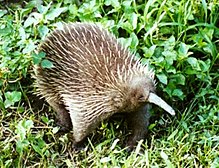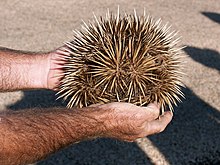I was asked about the image
of the albino Echidna and whether it was like a ‘Hedge Hog’? Echidna’s are
common throughout the area where I live. I often come across them during bushwalks, or, see their 'sign'. Mostly they tend to be nocturnal or like the early morning or late afternoon periods to come out to feed or mate.
Albino echidnas are very rare.
The hedgehog is
any of the spiny mammals of the subfamily Erinaceinae and the order Erinaceomorpha . There are 17 species of hedgehog in five genera,
found through parts of Europe, Asia, Africa,
and New Zealand (by introduction).
A foraging European Hedge Hog
There
are no hedgehogs native to Australia, and no living species
native to the Americas.
Hedgehogs
share distant ancestry with shrews (order Soricidae),
with gymnures possibly
being the intermediate link, and have changed little over the last 15 million
years. Like many of the first mammals they have adapted to a nocturnal, insectivorous
way of life. Hedgehogs' spiny protection resembles that of the unrelated rodent
porcupines and monotreme echidnas.
Hedgehogs are born blind. The hedgehogs are birthed with a protective membrane covering their quills, which dries and shrinks over the next several hours. The infants are born with quills beneath the skin, like pimples, and pass the skin after they have been cleaned.
The
name 'hedgehog' came into use around the year 1450, derived from the Middle English 'heyghoge', from 'heyg', 'hegge' = hedge, because it
frequents hedgerows,
and 'hoge', 'hogge' = hog, from its piglike snout. Other names include
'urchin', 'hedgepig' and 'furze-pig' .
European hedgehog
Depending on the species, the gestation period is 35–58 days. The
average litter is 3–4 newborns for larger species and 5–6 for smaller ones. As
with many animals, it is not unusual for an adult male hedgehog to kill newborn
males. Hedgehogs have a relatively long lifespan for their size. Larger species
of hedgehogs live 4–7 years in the wild.
The Echidna, also known as the "spiny anteater", belong to the family Tachyglossidae in the monotreme order of egg-laying mammals. There are four extant species, which, together with the platypus, are the only surviving members of that order and are the only extant mammals that lay eggs. Although their diet consists largely of ants and termites, they are no more closely related to the true anteaters of the Americas than to any other placental mammal.
They live in Australia and New Guinea. The echidnas are named after a monster in ancient Greek mythology.
Western long-beaked echidna
Echidnas and the platypus are the only egg-laying mammals, known as
monotremes. The female lays a single soft-shelled, leathery egg 22
days after mating, and deposits it directly into her pouch.
Hatching takes place after ten days; the young
echidna, called a puggle, then sucks milk from the pores of the two milk patches (monotremes have no nipples) and remains in the pouch for
45 to 55 days, at which time it
starts to develop spines. The mother digs a nursery burrow and deposits the
puggle, returning every five days to suckle it until it is weaned at seven
months.
The average wild echidna can grow as old as 16 years.
A short-beaked echidna curled into a ball, the snout is visible on the right
Male echidnas have a four-headed penis. During mating, the heads on one
side "shut down" and do not grow in size; the other two are used to
release semen into the female's two-branched reproductive tract. The heads used
are swapped each time the mammal copulates.

.jpg/220px-European_hedgehog_(Erinaceus_europaeus).jpg)



4 comments:
I don't think i have actually ever seen a hedgehog...and we have all sorts of wildlife in our woods...just waiting for my garden to harvest...
Without intending to be rude - you must really LOOK very closely to see them. They move very slowly, are extremely timid and are experts at camouflage - If they think they've bee spotted they will roll into a ball which even from close up looks like a bundle if small sticks!
I remember when we lived in Europe, my Mum bringing in a hedgehog, cradled in her apron, for us to look at. We thought it was the cutest little thing. She replaced it under the hedge outside...don't think we ever saw another one, ever.
Ahhuh! While there is a degree of 'cuteness' about an echidna, they are more of a mystery curio - very tough creatures, powerful digging claws that can scratch you if you try handling them and their quills can be 5 to 6 inches long and have been know to puncture vehicle tyres when ran over on the road - multiple puncture you cannot repair and so, for balance purposes, you need to replace BOTH tyres.
Post a Comment